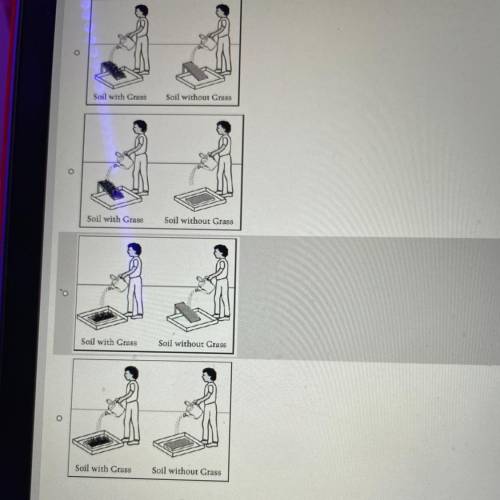
Rafael lives near a road at the bottom of the hill. His parents are concerned that soil will wash off the hill and rocks will fall onto the road. Rafeal converts an investigation to find out if grass growing on a hillside will help stop soil erosion. He collects two samples of the same size and type of soil. One sample of soil has grass growing on it and the other does not. He places each sample of soil in a small tray. For his investigation, Rafael pours the same amount of water onto both samples of soil. He uses a large tray to collect water that may flow through the soil. Which practice shows the best way for Rafael to set up this investigation?


Answers: 2


Another question on Physics

Physics, 22.06.2019 08:00
5g of ammonium nitrate was dissolved in 60g of water in an insulated container. the temperature at the start of the reaction was 23.0°c and at the end it was 19.0°c. calculate the energy absorbed by the reaction.
Answers: 3

Physics, 22.06.2019 12:00
An architect plans to use solar energy to heat the next house he designs. what principle of absorption and infrared energy can be applied to the design of the new house? how could she apply to those principals?
Answers: 2

Physics, 22.06.2019 18:30
Asled is being held at rest on a slope that makes an angle θ with the horizontal. after the sled is released, it slidesa distance d1 down the slope and then covers the distance d2 alongthe horizontal terrain before stopping. find the coefficient ofkinetic friction μk between the sled and the ground, assumingthat it is constant throughout the trip. find the coefficient of kinetic frictionμk. express your answer in terms of someor all of the variables d1, d2, and θ.
Answers: 1

Physics, 22.06.2019 20:50
An ideal otto cycle has a compression ratio of 8. at the beginning of the compression process, air is at 95 kpa and 27°c, and 750 kj/kg of heat is transferred to air during the constant-volume heat-addition process. assuming constant specific heats at room temperature, determine (a) the pressure and temperature at the end of the heat-addition process, (b) the net work output, (c) the thermal efficiency, and (d) the mean effective pressure for the cycle. (4390 kpa, 1730 k; 423 kj/kg; 56.4%; 534 kpa)
Answers: 1
You know the right answer?
Rafael lives near a road at the bottom of the hill. His parents are concerned that soil will wash of...
Questions

Business, 05.03.2021 04:40


Mathematics, 05.03.2021 04:40

History, 05.03.2021 04:40

Biology, 05.03.2021 04:40





Mathematics, 05.03.2021 04:40

Mathematics, 05.03.2021 04:40


Mathematics, 05.03.2021 04:40

History, 05.03.2021 04:40

Mathematics, 05.03.2021 04:40



History, 05.03.2021 04:40




